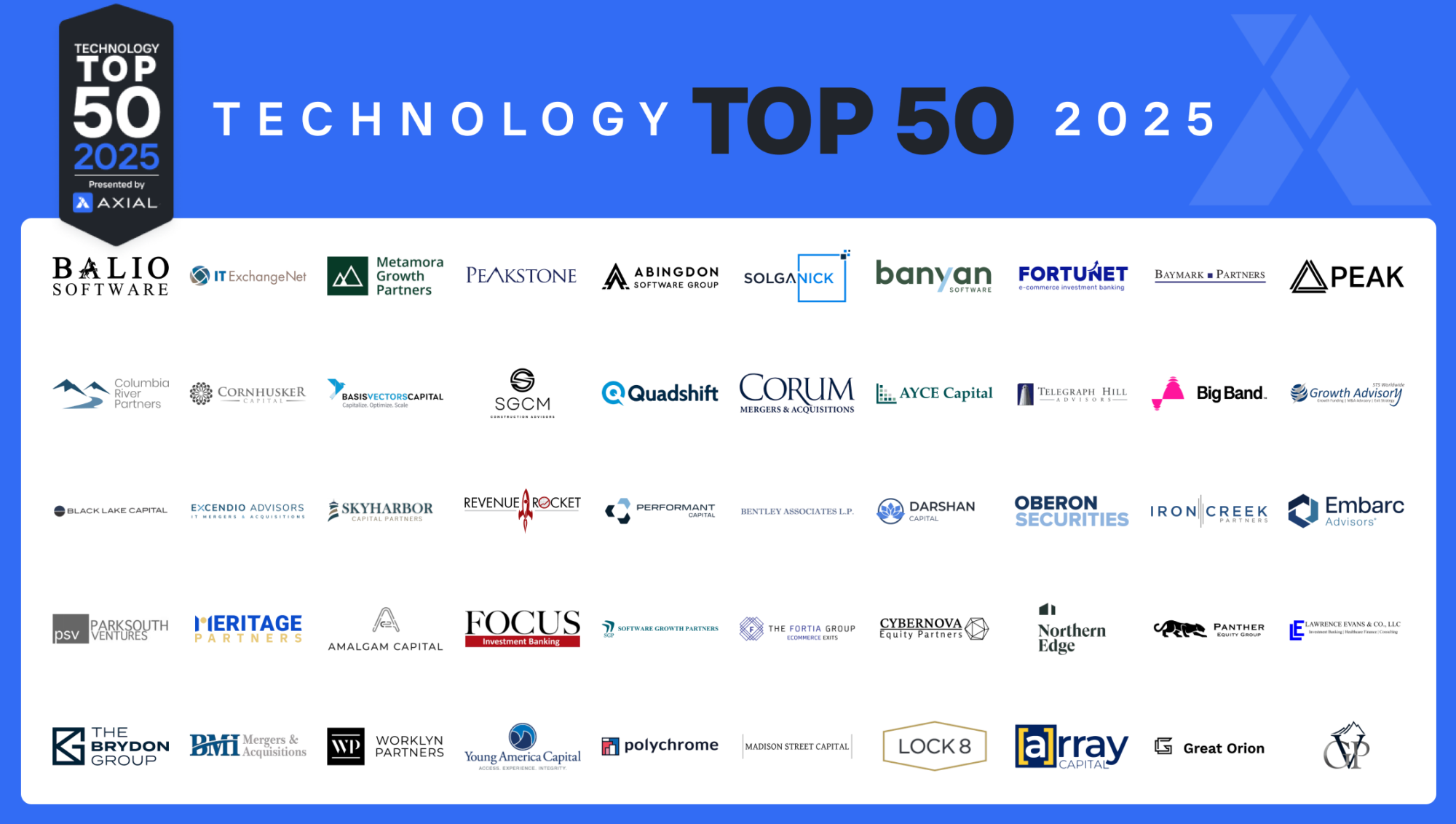
The Top 50 Lower Middle Market Technology Investors & M&A Advisors [2025]
Technology remains a steady presence in the lower middle market, representing ~13% of deals brought to market via Axial over…
All business development efforts have an ultimately simple aim: increase deal flow.
But what strategies have the biggest payoff? How can banks balance competing opportunities and goals?
Axial’s dedicated team of business development consultants works with scores of investment banks across the world on a regular basis. The team helps Axial members craft more targeted and effective BD strategies to source clients and ultimately close more deals.
We surveyed the team to learn more about secrets to success from their most successful clients, challenges that today’s banks face, and more.
Successful investment banks are well-oiled business development machines, integrating time-honored networking strategies with new online opportunities seamlessly to win on multiple fronts. On average, our BD consultants report that Axial members perform about 30-40% of their outreach online, compared to 60-70% offline.
Says Axial BD consultant Caitlin Walker, “The most successful bank I work with is extremely sales-minded, and calculates their prospecting by the numbers. Everything is measured. The bank’s leadership is aggressive in getting their team in front of their prospects very early in the process for in-person meetings. They understand the importance of the personal connection — but they also use all avenues of technology to maximize the top of their deal funnel.”
Proactive outreach is key to increasing the top of the funnel. Time-honored strategies like outbound calling complement newer tools like Axial, providing bankers multiple ways to find and reinforce relationships with prospective partners. Online tools are particularly useful for finding buyers outside a bank’s geographic area whom they may never have been aware of otherwise. Axial’s team of business development consultants report their most successful banks place between 50 and 200 outbound calls per month, with most placing between 50 and 100. Sending targeted emails (perhaps announcing recently closed deals, or featuring recent thought leadership pieces from the firm) is another popular strategy for cultivating interest in the firm.
Whether online or over the phone, a warm introduction is key to a successful outbound effort. Lead with a current priority, mutual connection, or shared interest — not with your firm’s latest objective. Think about what you’d actually be interested in hearing about if you were on the other end of the phone.
Axial consultants report that website development and online discoverability are two of the biggest challenges plaguing investment banks on Axial. With so many other projects going on, it can be hard to prioritize a project that may seem secondary to moving deals down the funnel.
But online presence isn’t secondary. Most investment banks already spend a large portion of time and money dedicated to promoting the firm’s offerings, specialities, and experience — whether over a one-on-one dinner, at an industry conference, or ad in a publication. If you aren’t discoverable online, all these efforts are more or less for naught. According to a survey of Axial members, 89% of CEOs look potential contacts online before doing anything else. If the CEO can’t find you when they Google you, they’re not going to dig through their pockets for your business card or call directory assistance to get your number. They’re just going to call the banker who comes up at the top of their search page.
Search engine optimization (SEO) is a method of getting your website to the top of searches “organically” (without putting money down on the table)— this requires proving to a mysterious algorithm that your content is highly relevant to those searching for a given keyword. Creating high-quality original online content is one way to boost SEO. You can also turn to paid advertising to leapfrog your way to the top.
But your online presence doesn’t stop with Google. Your website should be a professional and meaningful representation of your offerings and approach. Components might include:
When contemplating a website redesign with an outside agency, it makes sense to appoint one member of your team project manager to coordinate. Otherwise, the project may fall behind schedule or suffer from having too many cooks in the kitchen.
Don’t be intimidated by online marketing; it is a big job but every little bit you do will help. Start small if necessary, but don’t underestimate it’s importance. Do you attend 5 conferences a quarter? Is there one or two that’s less productive than the others? What if you allocated that money toward online marketing? The experiment will almost certainly pay dividends in the end.
Meanwhile, conferences provide an opportunity to meet more people and solidify relationships with additional contacts. The majority of successful Axial investment banks attend at least 1-3 conferences per month, with some prioritizing as many as 3-5.
Obviously, how many conferences you attend depends on your firm’s strategy and specializations. Industry-specific conferences and trade shows are a great place to brush up on trends and issues that are evolving in the industry. “Particularly for constantly changing sectors like healthcare or energy, these events are a great place to stay in the loop on upcoming regulatory changes that might affect business,” says Kristina Mayne, head of events at Axial. “Trade show attendees may not be used to seeing deal professionals — but that can work in your favor.”
“Encourage companies to tell you about their stories and business models,” Mayne continues. “But remember that these events aren’t aimed at deal sourcing. The goal for these events should be long-term relationship building, not short-term deal flow.”
Be sure to establish clear goals for your attendance at events, and for traveling in general. For more travel best practices, check out this article.
In general, maintaining long-term relationships is key to success as an investment bank. “You may reach out to one buyer who doesn’t end up being a fit for that specific deal. But they may end up being the right fit for the next deal that comes along,” says Fredika Slikkers, a business development consultant at Axial.
“Reciprocity is a huge way to create true, meaningful connections,” Slikkers continues. “Recommending a fellow banker that might be interested in a deal” is a great way to build connections and increase your future deal flow.
A lot of it comes down to long term vision. “A successful banker is planning now for the next 3-5 years. They’re open to speaking with people of different backgrounds, and creative about putting those people together with others,” says Axial BD consultant David Dietz.
